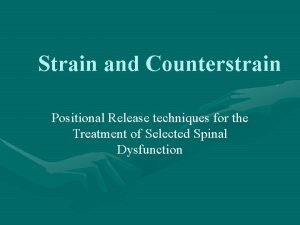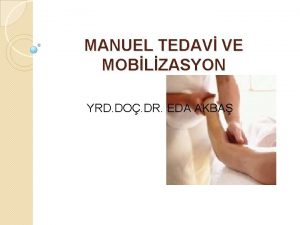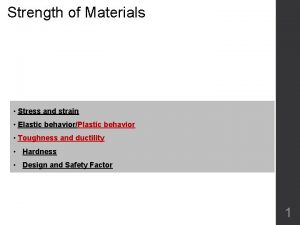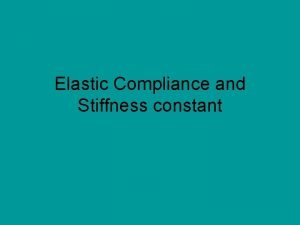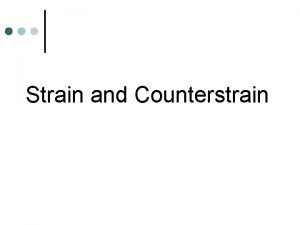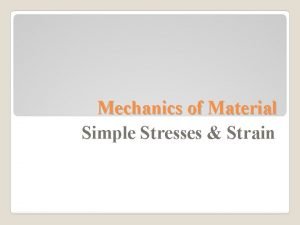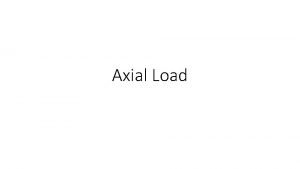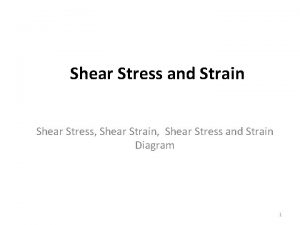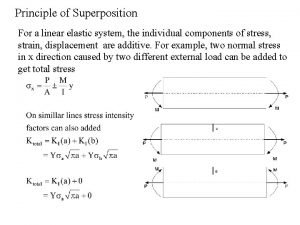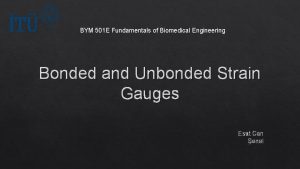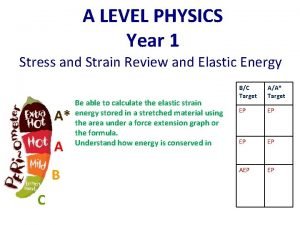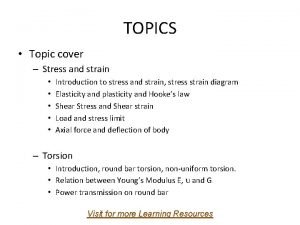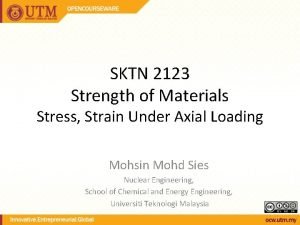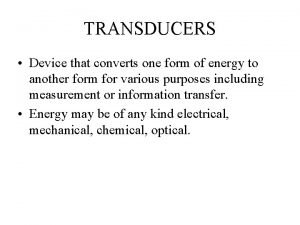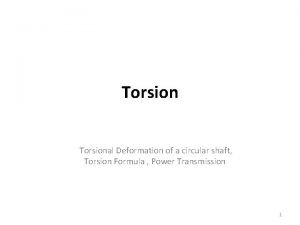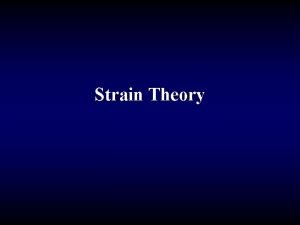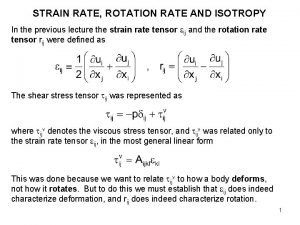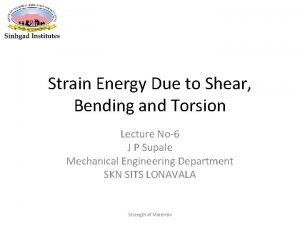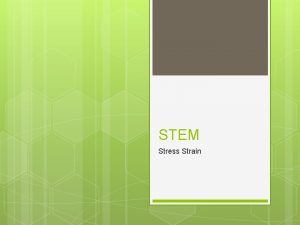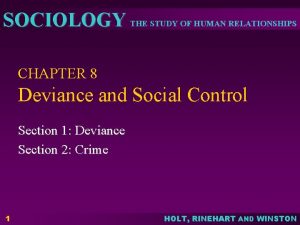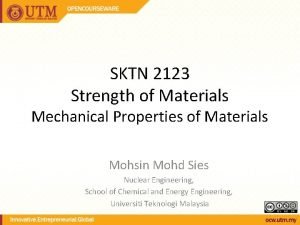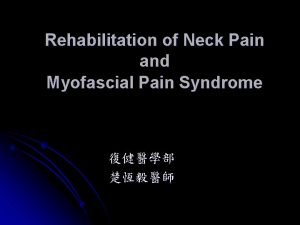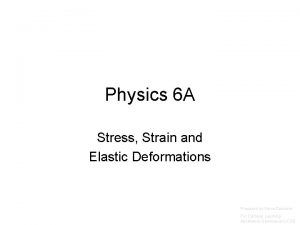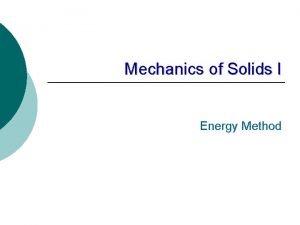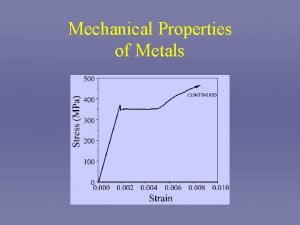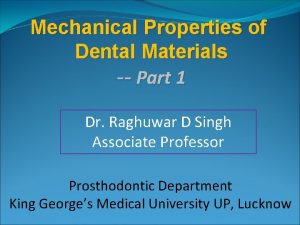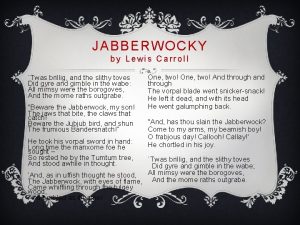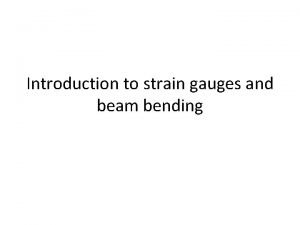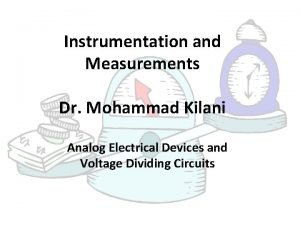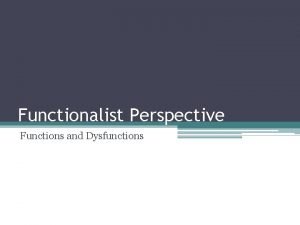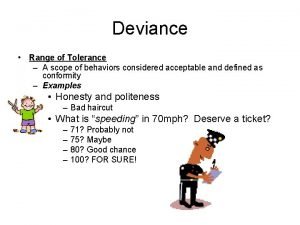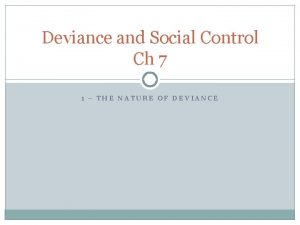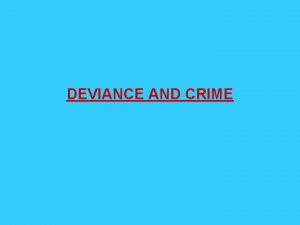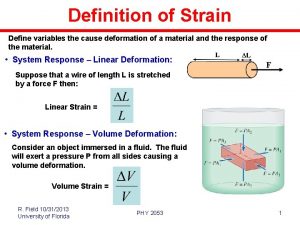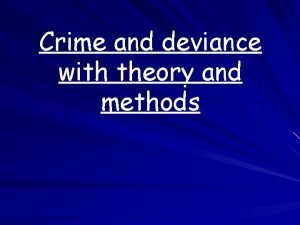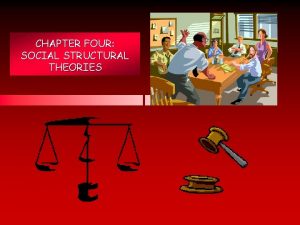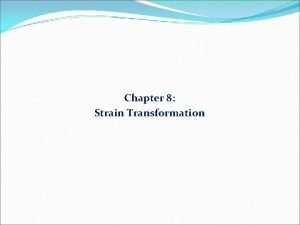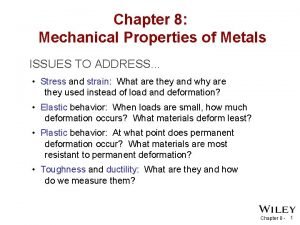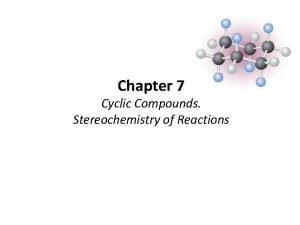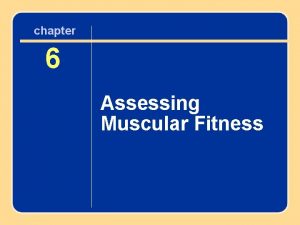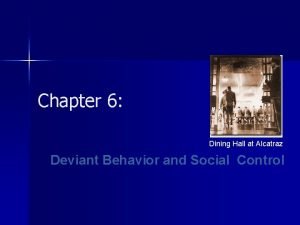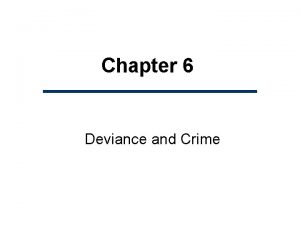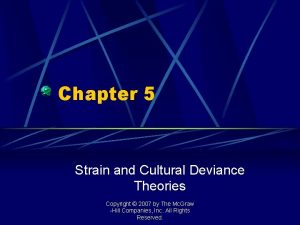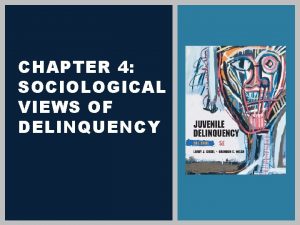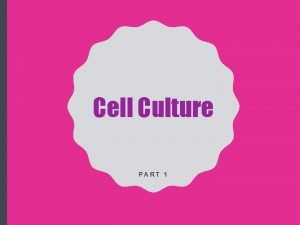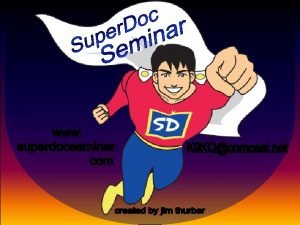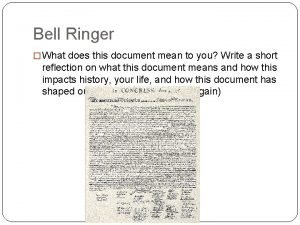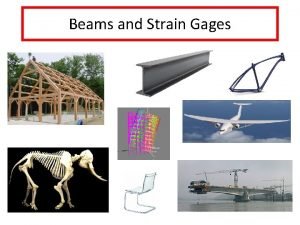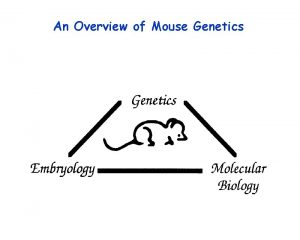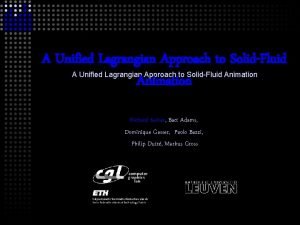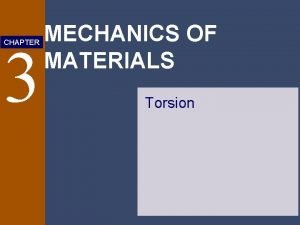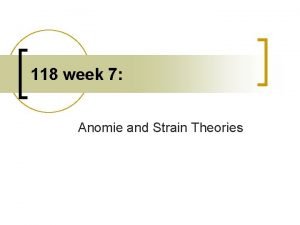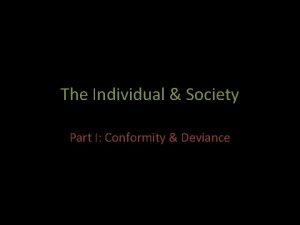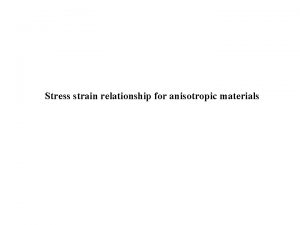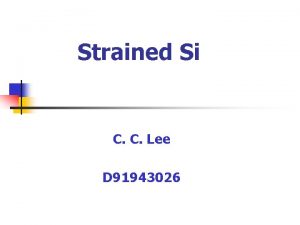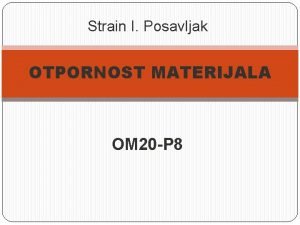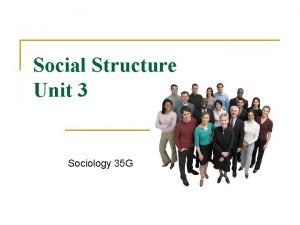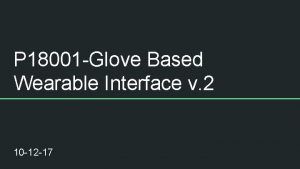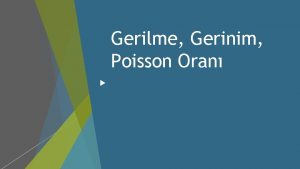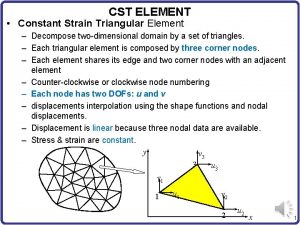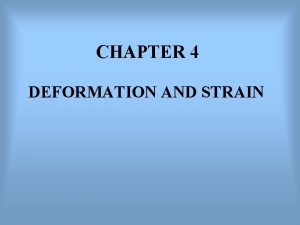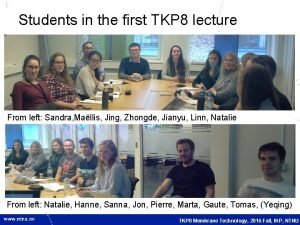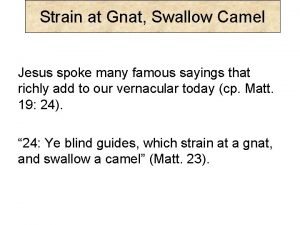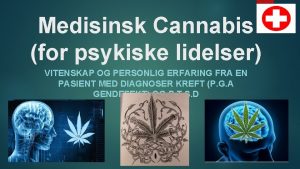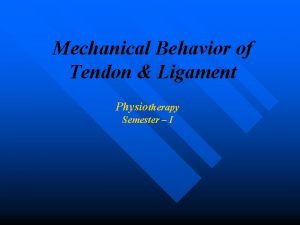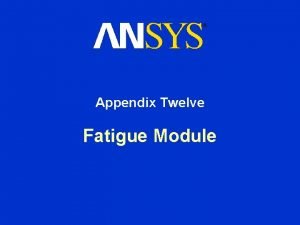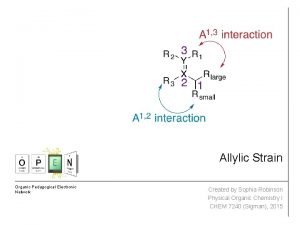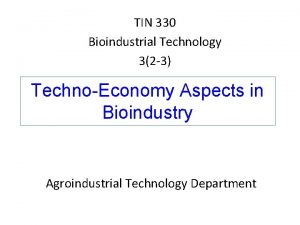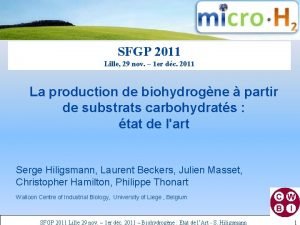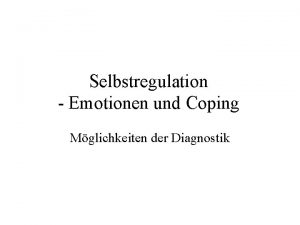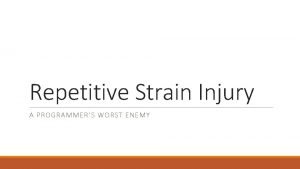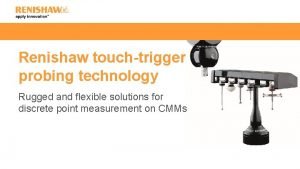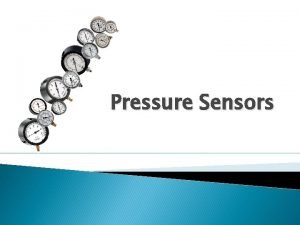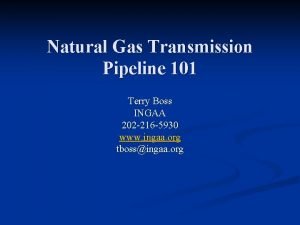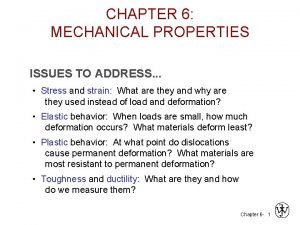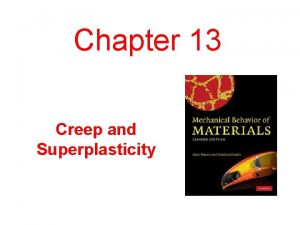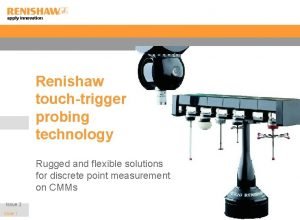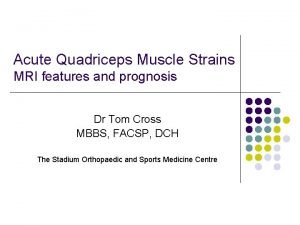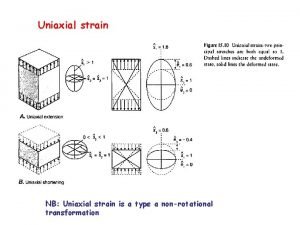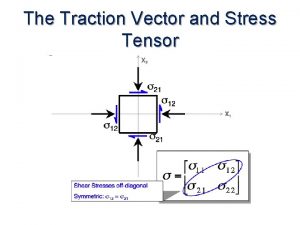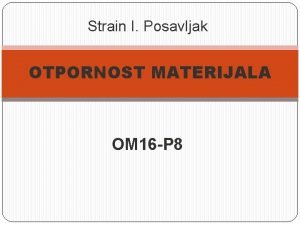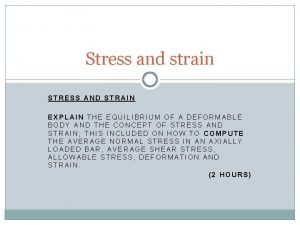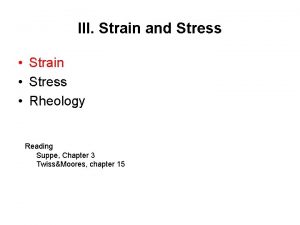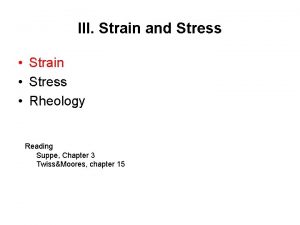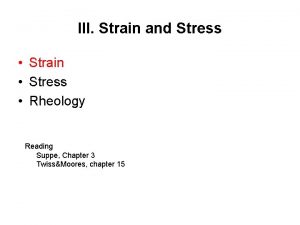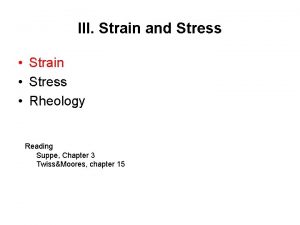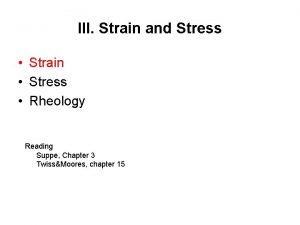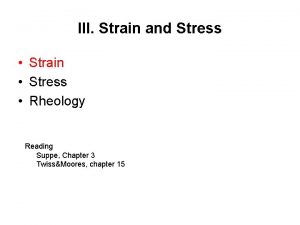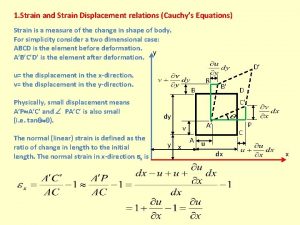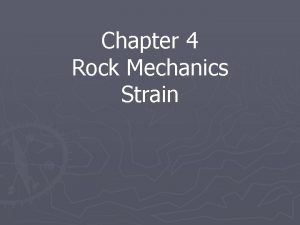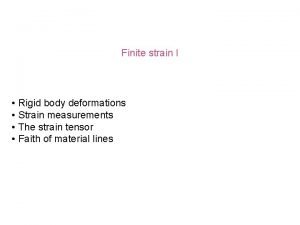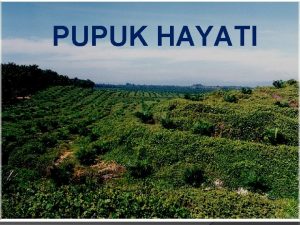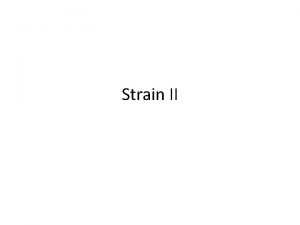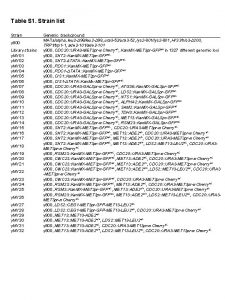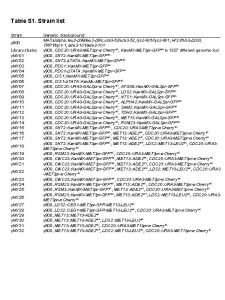Strain and Counterstrain LC 1 AC 2 AC



































































































- Slides: 99

Strain and Counterstrain

LC 1 AC 2 AC 3 TR AC 4 AC 5 AC 6 Anterior Cervical Tender Points ALC AC 7 AC 8 AC 1 reg AC 1 rare

Lateral C 1 -LC 1 (Rectus Lateralis) l l l ¢ Tenderpoint l ¢ Treat this first before anterior tender points Frontal headaches/eye pain Always treat with AC 1 On the transverse process of C 1 Treatment l l Supine Sidebend toward the side of the tenderpoint to exaggerate deformity. The mastoid process and transverse process of C 1 are approximated on the involved side.

AC 1 ¢ Tender point l l ¢ Posterior surface of ascending ramus of the mandible 2 cm superior to mandibular angle Approach posterioly Treatment l l l Supine Neutral flexion/extension Sidebend – away slightly Rotate – away markedly Direct motion with pressure on top of head

AC 1 (Rare) - Scalenes ¢ Tender point Beneath and medial ot the mandibular angle 2 cm anterior to angle l Push superiorly on the inferior surface l ¢ Treatment Supine l Flexion – marked l Sidebend – slightly toward l Rotate – away as needed l Treat inion point posteriorly l

AC 2 ¢ Tender point: l ¢ Anterior surface of the tip of C 2 Transverse Process Treatment: Supine l Flexion – slight ot none l Sidebend – Away (moderate – marked usually) l Rotate – away (moderate – marked usually) l

AC 3 ¢ Tender point l ¢ Anterior surface of tip of C 3 transverse process Treatment Supine l Flexion – marked l Sidebend – usually toward l Rotate – away (moderate) l

AC 4 ¢ Tender point l ¢ Anterior surface of tip of C 4 transverse process Treatment Supine l Extension – slight l Sidebend – away (moderate) l Rotate – away (moderate) l Exception to rule l

AC 5 ¢ Tender point l ¢ Anterior surface of tip of transverse process of C 5 Treatment Supine l Flexion – moderate l Sidebend – away (moderate) l Rotate – away (moderate) l

AC 6 ¢ Tender point l ¢ Anterior surface of tip of transverse process of C 6 Treatment Supine l Flexion – moderate l Sidebend – away (moderate usually) l Rotate – away (moderate usually) l

AC 7 ¢ ¢ Shorten sternocleidomastoid muscle – clavicle Tender point l ¢ Posterior superior surface of clavicle. Approximately 3 cm lateral to medial end. Push inferiorly on the superior surface of the clavicle Treatment l l Supine Flexion – marked; support lower neck, not head Sidebend – toward markedly Rotate – away slightly

AC 8 (SCM-sternal) ¢ Tender point Medial end of clavicle l Push laterally l ¢ Treatment Supine l Flexion – slight l Sidebend – away slightly l Rotate – away markedly l

TR (trachea) ¢ ¢ ¢ Tight swallowing Longus coli spasm Tender point l l ¢ Anywhere along either sid eof the trachea More common near the superior aspect Treatment l l Supine Flexion – marked, support lower neck Sidbend – toward markedly Rotate – away, slightly

ALC (Anterior Lateral Column) ¢ ¢ ¢ Longus coli muscle Common with flattened cervical lordosis Tender point l l ¢ On a vertical line medial to the SCM muscle and lateral to trachea Push posteriorly toward anterior aspect of vertebral bodies C 3 -6 Treatment l l Supine Flexion – marked of neck Sidebend – toward tender point side Rotate – away form tender point side

PC 1 Inion Posterior Cervical Tender Points PC 1 PC 2 PC 3 PLC PC 4 PC 5 PC 6 PC 7 PC 8

PC 1 (Inion) ¢ Tender point l ¢ On medial border of main posterior muscle mass of neck (semispinalis capitis), 3 cm below posterior occipital protuberance (inion) Treatment l l l Supine Flexion – marked (chin tuck position) Sidebend – toward slightly Rotate – away slightly Usually works better to monitor PC 1 than a. C 1 (rare) Treatment position very similar

PC 1 (regular) ¢ ¢ ¢ Frontal Headaches Tender point l On occiput lateral to main muscle mass l Approximately 3. 5 cm from midline Treatment l Supine l Extension – at C 1 level. Lift heat to create flexion of lower cervical region prior to extending C 1. Allows more extension. Augment extension of C 1 by hand pressure on top of head. l Sidebend – away slightly l Rotate – away slightly

PC 2 ¢ ¢ Frontal headaches and/or eye pain Tender point l l ¢ 1. on lateral side of main muscle mass of neck below occiput. 1. 5 cm lateral to midline 2. superior surface of the spinous process of C 2 Treatment l l Supine Extension – same as PC 1 Sidebend – away slightly Rotate – away slightly

PC 3 ¢ ¢ Pain up back of head, tinnitus, vertigo Tender point l ¢ On the inferior surface of the spinous process of C 2 Treatment l l Supine Flexion – marked Sidebend – away or toward Rotate – away

PC 4 ¢ ¢ Occipital heacaches, common with TMJ dysfunction Tender point l l l ¢ 1. on spinous process of C 3 in the depression below the spinous process 2. in muscle mass between C 4 spinous process and C 4 transverse process Forward bending of neck helps to palpate these points Treatment l l Supine with head over end of table Extension – to level or flexion Sidebend – away Rotate – usually away

PC 5 / PC 6 / PC 7 ¢ ¢ PC 5: whole head hurts Tender point l ¢ On spinous process of corresponding vertebrae above i. e. PC 6 on spinous process of C 5 Treatment l l l Supine Extension – marked to level Sidebend – usually away Rotate – away The main difference between these points and inferior to T 2 is how much extension or backward bending is utilized

PC 8 ¢ Tender points l ¢ Anterior to the trapezius at the base of the neck on the posterior surface of the tip of the C 7 transverse process (push up on transverse process) Treatment l l Supine Extension – slight Sidebend – away markedly Rotate – away (slight to moderate)

PLC (Posterior Lateral Column) ¢ Tender point l ¢ 2 cm lateral to the spinous processes of C 2 -C 7 Treatment Supine with head off end of plinth l Extension – moderate l Sidebend – toward moderate l Rotate – away l

AT 1 AT 2 AT 3 AT 7 Anterior Thoracic Tender Points AT 4 AT 5 AT 6 AT 8 AT 9 AT 10 AT 12 AT 11

AT 5 -AT 8 ¢ Requires lots of force ¢ Optional technique involves placing patient supine and fulcruming at level over knee/thigh of clinician. This allows greater thoracic flexion at AT 5 AT 7 ¢

Anterior thoracic tender points are typically more tender supine than sitting ¢ AT 1 -AT 6 ¢ Increased thoracic kyphosis l T 4 -T 5 pain posteriorly l Fatigued/ low energy l Increased difficulty with respiration – deep breath l

AT 7 -AT 12 ¢ Chronic diarrhea AT 10 ¢ Stomach problem AT 7 -AT 12 ¢ Thoracolumbar pain posteriorly ¢

AT 1 ¢ Tender Point l ¢ Midline in suprasternal notch. Push inferiorly. Treatment Seated with fingers interlocked on top of head. Clinician places arms around patient and locks hands over the manubrium. l Flexion – created by leaning patient’s trunk backward slightly l

AT 2 ¢ Tender Point l ¢ Middle of Manubrium Treatment l Seated, same as AT 1 but clinician locks hands lower at junction of manubrium and sternum

AT 3 ¢ Tender point l ¢ On sternum just below sternal angle Treatment l l l Seated with arms dropped back and off edge of plinth/table Clinician pulls backward/inferiorly on patient’s arms creating a fulcrum at the desired level. Clinician uses his chest and abdomen to force patient’s thoracic spine in flexion. Augment thoracic flexion by internally rotating arms Flexion of cervical region also

AT 4 Lethargy ¢ Tender point ¢ l ¢ On body of sternum at level of 4 th rib interspace Treatment Seated. Same as AT 3 but 1. 5 cm lower l Flexion l

AT 5 ¢ ¢ Lethargy Tender point l ¢ On body of sternum at 5 rth rib interspace level (at nipple line) Treatment l l Seated with arms at side. Clinician locks fingers anteriorly over the tender point. Flexion is created by pullingthe patient backward using medial edges of hands as the fulcrum. Clinician leans against patient’s upper thoracic area Flexion

AT 6 Grumpy point ¢ Tender point ¢ l ¢ Xiphisternal junction Treatment Seated with arms at side. Same as AT 5 but lower l Flexion l

AT 7 ¢ ¢ ¢ Stomach pain, gastritis Tender point 1. Under the costochondral margin of 7 th rib (pain with deep breath) 2. 2 cm below xiphoid. 1 cm lateral to midline Treatment l Seated. Clinician has his foot on the table. Patient has opposite arm resting on pillow on clinician’s thigh who stands behind patient. Patient’s feet side-straddle (on table on side of tenderpoint) l Flexion l Sidebend – toward by translating trunk to opposite side l Rotation – away by placing involved side arm across front of body

AT 8 ¢ Tender point l ¢ 2 cm below AT 7. 1. 5 cm lateral of midline Treatment l Same at AT 7 with more thoracic flexion

AT 9 ¢ Tender point l ¢ Just above umbilicus. 1. 5 cm lateral to midline Treatment l Same as AT 7 with more thoracic flexion

AT 10 ¢ ¢ Tender point l Just below umbilicus. 1. 5 cm lateral to midline l Can often feel anterior body of L 3 vertebrae 1. 5” in Treatment 1. Supine with head of table raised. Rest patient’s flexed legs on clinician’s thigh. Clinician stands on side of tender point. Produced marked flexion at the level of dysfunction. Rotate knees slightly toward tender side for fine tuning 2. Straight table technique – place pillows under “hips” to obtain flexion of pelvis on lumbar spine. Then proceed as above

AT 11 ¢ Tender point l ¢ Suprapubic region. 2 cm lateral to midline. Medial to ASIS levels Treatment l Same as AT 10 with fine tuning

AT 12 ¢ Tender point l ¢ Crest of ilium at mid-axillary line. On inner table of iliac crest. Push caudad at iliac crest Treatment l Same as AT 10. Fine tune

PT 1 -2 PT 3 -5 PT 6 -9 Posterior Thoracic Tender Points PT 10 -12

T 1 -5 – most often tender on sides of spinous processes. ¢ T 6 -12 – usually more sensitive paravertebrally or just lateral to spinous processes. ¢ TL junction – usually most sensitive on the posterior tips of the transverse processes. At times, lateral to the spinous processes. ¢

With posterior thoracic, the closer the tender point to the midline the more backward bending force is needed (split table helpful). ¢ The further the tender point from the midline, the more sidebending is needed. Sidebend away from the side of the tender point ¢

¢ ¢ ¢ Pre-position trunk or legs to create some sidebending away if/as necessary Transverse process – more sidebend than rotation Spinous process – more rotation than sidebend Diffuse posterior pain – usually have anterior tender points as well Localized specific posterior pain – posterior tender points

PT 1 / PT 2 ¢ Tender point l l ¢ Treatment l l ¢ On the side of the spinous process of T 1 and T 2 Occassionaly, PT 1 also has a tender point 2 cm above the lateral epicondyle at the elbow Prone with arms alongside body or supine with head off end of table Extension – if prone, cradle chin in palm and extend to level Sidebend – away Rotate – away T 1 -T 5 similar to lower posterior cervicals

PT 3 / PT 4 / PT 5 ¢ ¢ ¢ Tender point l On the side of the spinous process T 3, T 4, T 5 l Sometimes PT 4 has a tender point 2 cm above the medial epicondyle at the elbow Treatment l Prone with arms along side the head. Arm assists in obtaining extension l Extension – cradle chin in palm, extend to level l Sidebend – away l Rotate – away T 1 -T 5 similar to lower posterior cervicals

PT 6 / PT 7 / PT 8 / PT 9 ¢ Tender point l ¢ Lateral to spinous process, 2 cm or less Treatment l l l PT 6 through PL 2 Prone. Arm of involved side alongside head. Opposite arm hangs off side of table. Raise arm of involved side by grasping axilla. Pull arm cephalad with slight traction effect Extension – slight, more for lower levels Sidebend – away, main force used is sidebending Rotate – trunk toward Place cervical spine in rotation to side of tender point

PT 10 / PT 11 / PT 12 / PL 1 / PL 2 ¢ Tender point l ¢ Lateral to spinous process or on tip of transverse process Treatment l l l Prone Raise cephalic end of table to extend to level Pull back on anterior pelvic on tender point side to sidebend and rotate Sidebend – away Rotate – pelvis toward 30 o-45 o PL

AR 2 AR 1 Anterior Ribs – Depressed Tender Points AR 3 -6 INT 4 -6

AR 1 ¢ Tender point l ¢ Beneath the clavicle on the first costal cartilage to the sternum Treatment l l Supine Mild cervical flexion Rotate – toward, markedly Sidebend – toward. Greatest force is applied in sidebending

AR 2 ¢ Tender point 1. On second ribs in mid-clavicular line 2. . High in medial axilla ¢ Treatment l ¢ Same as AR 1 With decreased shoulder abduction, be sure to check AR 1 -AR 2

AR 3 – AR 6 ¢ Tender point l ¢ On anterior axillary line inferior rib margins at corresponding levels Treatment l l Sitting Flexion – slight, neck and trunk Sidebend – toward. This is accomplished by leaning patient to opposite side with the patient’s axilla on clinician’s knee (who is standing behind patient). Sidebend toward by translating patient’s trunk away from tender point. If patient’s feed are on plinth on tender point side, the sidebend can be increased Rotate – toward. Let involved side arm hang behind patient to augment

INT 4 – INT 6 ¢ Tender point l ¢ On or between costal cartilage just lateral to sternum at the corresponding level Treatment l l l Patient seated and leaning toward opposite side with opposite axilla supported on clinician’s knee. Clinician standing behind patient. Cervical flexion Patient’s feet on table on tender point side Trunk flexion Sidebend – toward. Created by translating trunk away Rotate – away, by placing patients involved side arm across front of body

PR 1 Posterior Ribs – Elevated Tender Points PR 2 -6

PR 1 ¢ Tender point l ¢ Posterolateral aspect of first rib, beneath the margin of trapezius at side on neck Treatment l l l Sitting Opposite axilla over clinician’s knee, lean patient mildly toward opposite side, then position head/neck Extension – mild Sidebend – away, mild Rotate – toward, moderate

PR 2 – PR 6 ¢ ¢ Tender point l Posteriorly at angle of ribs on superior surface. Adduct patient’s arm across front of body to move scapula laterally and allow easier palpation of rib angles Treatment l Sitting l Axilla on affected side is resting on clinician’s knee. Lean patient toward tender point side. Opposite arm is hanging loosely behind patient’s back. Patient’s feet are on table opposite of tender point side. l Sidebend – away by translating trunk toward tender point side. l Rotate – away For 2 nd rib, rotate neck away moderately also Treat spinal tender points (thoracic) before rib tender points, even if somewhat more tender

Anterior Lumbar Tender Points Ab. L 2 AL 1 AL 2 AL 3 AL 4 AL 5

¢ AT 9 -AL 1 l ¢ AL 1 & AL 2 l ¢ Often involved with patient who can’t stand upright AL 3 & AL 4 l ¢ Similar procedure for 5 levels Virtually no rotation. Sidebend through legs AL 2 & AL 5 l Are the “key” tender ponts in this area

AL 1 ¢ Tender point l ¢ Medial to anterior superior iliac spine. ¾” deep. Push medial to lateral Treatment l l l Supine with head of table elevated Patient’s flexed legs rest on clinician’s thigh Clinician on tender point side Flexion – marked at level of dysfunction Sidebend – mild, toward Rotate – knees toward tender point side

AL 2 ¢ Tender point l ¢ Medial inferior surface to anterior inferior iliac spine Treatment Supine l Clinician opposite tender point side l Flexion – patient’s legs flexed 90 o l Rotate – knee away from tender point 60 o (markedly) l Sidebend – away, slightly. Push feet toward floor l

Ab. L 2 (Abdominal ¢ Tender point l ¢ 5 cm lateral to umbilicus Treatment Supine l Clinician on tender point side l Flexion – more than AL 2 l Rotate – knee toward tender point (60 o) l Sidebend – away. Elevate feet upwards to create l

AL 3 ¢ Tender point l ¢ Lateral surface of anterior inferior iliac spine Treatment l l l Supine Clinician opposite tender point side Flexion – flex thighs 50 o – 90 o Sidebend – away markedly by pulling feet toward clinician Rotate – slightly to fine tune

AL 4 ¢ Tender point l ¢ Inferior surfaced of anterior inferior iliac spine Treatment l Same as AL 3 with fine tuning

AL 5 ¢ Tender point l ¢ Anterior surface of pubic bone, 1. 5 cm lateral to pubic symphysis Treatment l l l Supine Clinician on tender point side Flexion – flex thighs 60 o – 135 o Sidebend – away, slightly Rotate – knees toward side of tender point

PL 1 QL PLRL 2 Posterior Lumbar Tender Points PL 3 PL 4 UPL 5 PL 3 (Iliac) PL 5 PL 4 (Iliac) LPL 5

PL 3 (Iliac) ¢ Tender point l ¢ 3 cm below margin of ilium and about 7 cm lateral to posterior superior iliac spine Treatment l l l Prone Clinician on side opposite tender point Extension – lift leg on affected side and support on clinician’s thigh Adduct – mild Rotate – full external. The higher the hand placement o the thigh by the operator, the greater the external rotation created

PL 4 (Iliac) ¢ Tender point l ¢ 4 cm below margin of ilium and just posterior to the border of the tensor fascia lata Treatment l l l Prone Clinician on side opposite the tender point Extension – same as PL 3 Adduct – slight Rotate – moderate external rotation

UPL 5 (Upper Pole) ¢ ¢ Tender point l Superior medial surface of the posterior superior iliac spine. l Apply pressure caudad and lateral toward posterior superior iliac spine (45 o angle) Treatment l Prone l Clinician on side opposite tender point l Extension – via leg. Major movement required l Adduct – very slight l Rotate – mild external rotation

LPL 5 (Lower Pole) ¢ Tender point 1. 2 cm below posterior superior iliac spine in small saddle between posterior superior iliac spine and posterior inferior iliac spine 2. on sacral promontory in midline ¢ Treatment l l l Prone Clinician seated on tender point side Leg on tender point side is dropped off table and resting on clinician’s thigh. Patient’s hip flexed approximately 90 o patient’s pelvis is rotated posteriorly and hip adducted slightly by pressure at the knee Flexion – hip 90 o Adduction – slight Rotation – pelvis rotate posteriorly

QL (Quadratus Lumborum) ¢ ¢ Tender point 1. On the lateral tips of the transverse processes of L 2 -4 2. In the angle between the transverse process of L 1 and the 12 th rib Treatment l Prone l Sidebend trunk toward tender point side l Sidebend legs toward tender point side l Abduct and extend hip of (on tender point side) and rest on clinician’s thigh l Gently hike hip and fine tune with mild rotation (internal or external l Extension –hip, mild l Abduction – hip, moderate l Rotate – fine tune, mild

¢ May complain of Lateral trunk shift l Decreased sidebend away l Pain with prolonged sitting l Pain rolling in bed l

PLRL 2 (Posterior Flexed L 2) (Psoas Major Muscle) ¢ ¢ Tender point l Over the posterior aspect of transverse process of L 2 Treatment l Prone l Clinician sits on same side as tender point l Flexion – hip off edge of table to 90 o and support patient’s knee on clinician’s thigh l Abduction – hip, slight to nont l Rotation – fine tune by using clincian’s t high to direct a force up the shaft of femur to rotate pelvis

Vertical lumbar pain on tender point side ¢ Difficulty finding comfortable sleep position ¢ Restless leg syndrome ¢

IL ALT AMT Anterior Pelvis / Hip Tender Points LISI ING ADD LIFO GMi/TFL

LISI (Low Ilium – Sacoiliac) ¢ Tender point On superior surface of lateral ramus of pubic bone. 2 cm lateal to pubic symphysis l Push cadad l ¢ Treatment Supine l Flexion – 90 o to 110 o of hip on tender point side l Sidebend – none l Rotate – none l

LIFO (Low Ilium – Flareout) ¢ Tender point l ¢ Treatment l l ¢ Inferior medial surface of the descending ramus of the pubic bone (start palpation at ischial tuberosity) Supine Flexion –patient’s thigh Abduct femur moderately to accentuate the low flareout Rotate femur externally – markedly by pushing the foot toward the midline Treat LIFO before LISI

AMT (Anterior Medial Trochanter) (Rectus Femoris) ¢ Tender point l ¢ 1 cm lateral to the anterior inferior iliac spine (AIIS) Treatment Supine l Flex hip 130 o l Abduct – none l Rotate – none l

ALT (Anterior Lateral Trochanter) (Sartorius) ¢ Tender point l ¢ 2 cm lateral to AIIS. Flex the hip to find this tender point Treatment Supine l Flex hip 90 o l Abduct – moderate l Rotate – external, little or none l

IL (Iliacus) ¢ Tender point l ¢ Anterior and deep in iliac fossa (push posterior and medial) Treatment Supine l Patient’s ankles supported on clinician’s thigh. Extreme flexion of hips and external rotation of both femurs. Full abduction l

ING (Inguinal Ligament) ¢ ¢ Hip internal rotator dysfunction Tender point l Lateral surface of pubic bone just below the inguinal ligament attachment. Push medial Treatment l Supine l Clinician stands on tender point side l Flexion – flex hip 90 o and rest on clinician’s thigh. Move the leg on the tender point side under opposite leg of patient. This produces crossing of knees and thighs l Adduction of femur l Rotate – internal rotation of femur Groin pain

ADD (Adductor) ¢ Tender point 1. Origin of adductors to pubic bone 2. Occasionally in muscle belly ¢ Treatment l l Supine Adduction – marked Cross leg of tender point side in front of opposite leg Flexion – slight

GMi (Gluteus Minimus) ¢ Tender point l ¢ Anterior border of gluteus minimus muscle. Superior and anterior to the greater trochanter. Push posterior and medical above greater trochanter Treatment Supine l Flexion – hip to 90 o l Abduction – slight l Rotate – marked internal l

TFL (Tensor Fascia Lata) ¢ Tender point l ¢ Belly of TFL muscle approximately 6 cm cephalad anterior to the greater trochanter Treatment Supine l Flexion – hip 90 o-100 o l Abduction – hip, slight l Rotation – draw foot laterally to create internal rotation of hip l

SAR (Sartorius) (Connection with RK Technique) ¢ Tender point l l l ¢ 1. Proximal tendon 2 cm lateral from anterior inferior iliac spine 2. Mid belly of muscle 3. Distal sartorius on medial side of knee (RK) Treatment l l Supine Flexion – hip and knee 90 o Abduction – hip, moderate Rotation – external, moderate

HISI PLT Posterior Pelvis / Hip Tender Points MPSI HFO-SI PMT GM PIR LT

HISI (High Ilium – Sacroiliac) Common ¢ Tender point ¢ l ¢ 3 cm lateral to the posterior superior iliac spine Treatment Prone l Extension – hip, supported on clinician’s thigh l Abduct - slight l

HFO-SI (High Flare-Out Sacroiliac) ¢ ¢ May be associated with coccygodynia Tender point l l ¢ 1. 4 cm below and slightly medial to PSIS in the area of the inferior lateral angles of the sacrum Occasionally on the ischial tuberosity Treatment l l Prone Clinician on side opposite tender pont Raise leg on the tender point side high enough to clear opposite leg and adduct across, scissoring the legs Correction is by increasing/accentuating the high ilium and flareout. Occasionally, the opposite leg is extended mildly and adducted

MPSI (Mid-Pole Sacoiliac) ¢ ¢ Ilium flare in - superiorly Tender point l l ¢ Treatment l l l ¢ Middle of the buttocks in slight depression Direct palpating finger medially (located medial to piriformis) Prone Extension – slight, occasionally slight flexion Abduction – moderate, major component Helpful with dysmenorrhea, may decrease cramping intensity by 50 -60%

PIR (Piriformis) ¢ ¢ Tender point l In the muscle belly, 8 cm medial and slightly cephalad to the greater trochanter Treatment 1. Similar to LP 5 l Prone l Clinician seated on tender point side l Leg on tender point side suspended off side of table with patient’s anterior aspect on ankle resting on operator’s thigh l Flexion – 120 o at hip l Abduct –moderate, horizontally l rotate – usually internal l Piriformis – muscle belly 2. Occasionally will clear with the posterior lateral trochanter technique (easier) l Piriformis - tendon

PLT (Posterior Lateral Trochanter) ¢ ¢ Hip external rotator dysfunction Tender point l l l ¢ Posterosuperior lateral surface of greater trochaner Tender point is near the insertion of the piriformis muscle Push anterior and medial Treatment l l l Prone Clinician on tender point side Extension – hip, support thigh on clinician’s knee Abduction – slight Rotate – marked external

PMT (Posterior Medial Trochanter) ¢ Tender point l ¢ On a line from the lateral inferior surface of ischial tuberosity to the medial aspect of the posterior surface of the femur Treatment l l l Prone Clinician on side opposite tender point Clinician pins patient’s ankle in his/her axilla Extension – hip, moderate Adduction – marked Rotate – marked external

LT (Lateral Trochanter (LT) ¢ Tender point l ¢ 12 cm below greater trochanter on lateral side of the shaft of the femur. Push medially Treatment Prone l Flexion – hip, minimal l Abduction – hip l Rotate – hip, internal or external, slight l

GM (Gluteus Medius) ¢ Tender point On a line 1 cm below the iliac crest l Follow medial to lateral with palpation l ¢ Treatment Prone l Clinician on tender point side l Extension – hip, clinician places knee under patient’s thigh l Abduction – hip, moderate l Rotate – marked, internal l

S 1 Sacral Tender Points S 1 S 2 S 3 S 5 S 4

PS 1 ¢ ¢ Backward sacral torsion dysfunction Tender point l ¢ 1. 5 cm medial to inferior aspect of PSIS bilaterally Treatment l l l Prone Apply a downward pressure (toward table) on the opposite corner of the sacrum from which the tender point is found to produce rotation around an oblique axis Twist heel of hand for subtle fine tuning/rotation

PS 2 ¢ ¢ Sacral extension dysfunction Tender point l ¢ Midline on sacrum between the first and second spinous tubercles Treatment l l l Prone Apply a downward pressure to the apex of the sacrum in midline to produce rotation around a transverse axis Twist heel of hand for subtle fine tuning/rotation

PS 3 Sacral extension dysfunction ¢ Tender point ¢ l ¢ Midline on sacrum between the second and third spinous tubercles Treatment Prone l Apply a downward pressure to the apex of the sacrum in midline l Twist heel of hand for subtle fine tuning/rotation l

PS 4 Sacral flexion dysfunction ¢ Tender point ¢ Midline on sacrum just above sacral hiatus l Approach inferior to superior l ¢ Treatment Prone l Apply a downward pressure to the sacral base in midline l Twist heel of hand for subtle fine tuning/rotation l

PS 5 ¢ ¢ Forward sacral torsion dysfunction Tender point l ¢ 1 cm medial and 1 cm superior to the inferior lateral angles bilaterally Treatment l l l Prone Apply a downward pressure to the opposite corner of the sacrum from where the tender point is found Twist heel of hand for subtle fine tuning/rotation

CYX (Coccyx Point) Coccygodynia ¢ Tender point ¢ l ¢ Either side of tip of coccyx Treatment Prone l Apply a downward pressure to the apex of the sacrum l Rotate sacrum toward side of tender point (95%). Rotate away from the side of tender point (5%) l
 Strain counterstrain
Strain counterstrain Doedo doktor eda
Doedo doktor eda Elastic strain and plastic strain
Elastic strain and plastic strain Elasticdeformation
Elasticdeformation Anterior lumbar counterstrain points
Anterior lumbar counterstrain points Site:slidetodoc.com
Site:slidetodoc.com Simple stresses
Simple stresses St venant principle
St venant principle Stresses
Stresses Principle of superposition in stress and strain
Principle of superposition in stress and strain Unbonded strain gauge
Unbonded strain gauge Anomie strain theory definition
Anomie strain theory definition Strain energy formula a level physics
Strain energy formula a level physics Stress and strain reading outline
Stress and strain reading outline Saint venant principle
Saint venant principle Basic requirements of transducer
Basic requirements of transducer What is torsional deformation
What is torsional deformation Social strain theory
Social strain theory True fracture strain
True fracture strain Species vs strain
Species vs strain Strain theory criminology
Strain theory criminology Strain tensor for velocity field
Strain tensor for velocity field Strain energy stored in beam
Strain energy stored in beam Stemstress
Stemstress Structural strain theory sociology
Structural strain theory sociology Strain offset method
Strain offset method Physical modalities
Physical modalities Strain formula
Strain formula Strain energy example
Strain energy example Elastic strain recovery
Elastic strain recovery Proportional limit in dentistry
Proportional limit in dentistry 'twas brillig
'twas brillig Gauge factor formula
Gauge factor formula Dc current measurement
Dc current measurement Functions and dysfunctions of deviance
Functions and dysfunctions of deviance Deviant examples
Deviant examples Victim discounting example
Victim discounting example Strain theory sociology
Strain theory sociology Strain define
Strain define Strain theory sociology
Strain theory sociology Stress strain coping support model
Stress strain coping support model Structural strain theory sociology
Structural strain theory sociology Principal strain equation
Principal strain equation Elastic strain recovery
Elastic strain recovery ..
.. Fitness 66 chapter
Fitness 66 chapter Five adaptations of strain theory
Five adaptations of strain theory Social strain theory
Social strain theory Cultural deviance theory
Cultural deviance theory Strain theory sociology
Strain theory sociology 10 cm dish surface area
10 cm dish surface area Finite and continuous cell lines
Finite and continuous cell lines Brain strain game
Brain strain game Bell ringer strain
Bell ringer strain Cross section moment of inertia
Cross section moment of inertia Congenic strain
Congenic strain Strain energy
Strain energy Torsion mechanics of materials
Torsion mechanics of materials 5 modes of adaptation strain theory
5 modes of adaptation strain theory Five adaptations of strain theory
Five adaptations of strain theory Strain energy
Strain energy Silver summit strain
Silver summit strain Deviant examples
Deviant examples Orthotropic and anisotropic materials
Orthotropic and anisotropic materials Ge strain
Ge strain Strain posavljak
Strain posavljak Role strain
Role strain Status set
Status set Velvet glove strain
Velvet glove strain Stress strain grafiği
Stress strain grafiği Baeyer strain theory
Baeyer strain theory What is
What is Anomie theory examples
Anomie theory examples Flinn diagram
Flinn diagram Tkp strain
Tkp strain Strain the gnat
Strain the gnat Sqa academy course
Sqa academy course Bedrocan norge
Bedrocan norge Stress strain curve physiotherapy
Stress strain curve physiotherapy Strain life parameters ansys
Strain life parameters ansys Allylic strain
Allylic strain Flexor strain elbow
Flexor strain elbow Strain selection
Strain selection Strain selection
Strain selection What is sentence fluency
What is sentence fluency Coping arten
Coping arten Enemy of the state strain
Enemy of the state strain Strain gauge
Strain gauge Bellows pressure gauge advantages and disadvantages
Bellows pressure gauge advantages and disadvantages Terry boss
Terry boss Hytek fuel
Hytek fuel Deformation strain
Deformation strain Mukherjee-bird-dorn equation
Mukherjee-bird-dorn equation Strain gauge
Strain gauge Unipennate
Unipennate Strain notation
Strain notation Uniaxial strain
Uniaxial strain Stress sign convention
Stress sign convention Strain improvement by mutation
Strain improvement by mutation Strain posavljak
Strain posavljak
